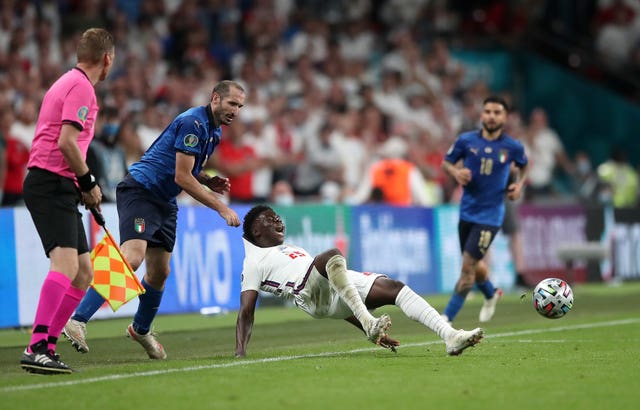
Blue cards will be shown to players sin-binned in new trials to indicate they must spend 10 minutes in the technical area, the PA news agency understands.
The Daily Telegraph first reported the use of the cards on Thursday and it is understood these will be shown by referees as part of a new trial.
Dissent and tactical fouls, like Giorgio Chiellini’s tug on England’s Bukayo Saka in the Euro 2020 final, will count as blue card offences.

Full details of the International Football Association Board (IFAB) trial protocols are set to be published on Friday.
PA understands the initial trial phase will not feature top-level competitions to avoid players being in events with different rules concurrently.
FIFA said “reports of the so-called ‘blue card’ at elite levels of football are incorrect and premature”.
The global governing body added in a post on X, formerly Twitter: “Any such trials, if implemented, should be limited to testing in a responsible manner at lower levels, a position that FIFA intends to reiterate when this agenda item is discussed at the IFAB AGM on 2 March.”
FIFA wishes to clarify that reports of the so-called 'blue card' at elite levels of football are incorrect and premature.
Any such trials, if implemented, should be limited to testing in a responsible manner at lower levels, a position that FIFA intends to reiterate when this…
— FIFA Media (@fifamedia) February 8, 2024
It is understood the Football Association is considering the possibility of trialling sin-bins in men’s and women’s FA Cups in the future.
The IFAB, which sets the laws of the game, also supported a proposed trial at its annual business meeting in November whereby only the team captain may approach the referee in certain major game situations.
Board member Mark Bullingham, the chief executive of the FA, said at an annual business meeting last November: “When we were looking at sin bins – protocol clearly has to be developed – the areas we were looking at were dissent, where it’s worked very, very well in the grassroots game in England.
“We’ve also spoken about other areas, particularly tactical fouls.

“I think frustration for fans watching games when they see a promising counter-attack that’s ruined by that and the question of whether a yellow card is sufficient for that has led to us looking at whether that should be involved in the protocol as well.
“The starting point was looking at player behaviour and dissent – we’re then looking at whether we should extend it into other areas, such as tactical fouls, as well.”
Sin-bins were introduced across all levels of grassroots football from the 2019-20 season in an attempt to to improve levels of respect and fair play in the game.
The rule change was implemented up to step five of the National League system and tier three and below in women’s football.

Enjoy the convenience of having The Sunday Post delivered as a digital ePaper straight to your smartphone, tablet or computer.
Subscribe for only £5.49 a month and enjoy all the benefits of the printed paper as a digital replica.
Subscribe